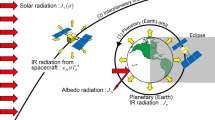Abstract
Space Power Satellite (SPS) is a huge spacecraft to utilize solar energy in space. Because of the huge size, immense mass and high power, there exist many technical difficulties. For a GW SPS system, the generated electric power in space will be over 2 GW, and the whole area of the solar array will be several square kilometers. The high-power electricity generation, transmission and management in space becomes a huge challenge. In the paper, the primary scheme of MR-SPS concept is presented and two important sub-systems, Solar Energy Collection and Conversion (SECC), Power Transmission and Management (PTM) are introduced. The SECC sub-system includes fifty solar sub-arrays. Each solar sub-array is composed of twelve solar array modules. The area of each solar sub-array is about 0.12 km2. The solar sub-arrays transmit electric power to the cables installed on the main structure of MR-SPS by 100 middle power rotary joints. PTM sub-system converts, transmits and distributes the output electric power of SECC sub-system. Most of electric power is transmitted to the antenna and is distributed in the antenna. The remaining electric power is transmitted and distributed to the service equipments for the operation of SPS. The mix of distributed and centralized high-voltage PTM is adopted to meet the requirement of electric power supply of the electric equipments on SPS. Typical space environment influencing high-power electric system is analyzed. The key technologies need to be researched and solved including high-efficient, long-life thin-film GaAs PV cell, ultra-large–high-voltage (500 V) solar array module, high-power conductive rotary joint, ultra-high-voltage (20 kV) cables, high-power converter, high-power switch, etc., and assembly and maintenance of the sub-systems.






Similar content being viewed by others
References
Glaser PE (1968) Power from the sun: its future. Science 162:867–886
Mankins JC (2018) Fifty years of space solar power. In: 69th International Astronautical Congress, Bremen, Germany
Arya M, Lee N, Pellegrino S (2016) Ultralight structures for space solar power satellites. In: 3rd AIAA spacecraft structures conference, San Diego
Ian Cash (2017) CASSIOPeiA Solar Power Satellite, WISEE
Ian Cash (2018) CASSIOPeiA—A new paradigm for space solar power. In: 69th International Astronautical Congress, Bremen, Germany
Choi J-M (2019) Conceptual design of Korean space solar power satellite. In: 70th international astronautical congress, Washington D.C.
Mihara S, Mae Kawa K, Nakamura S et al (2018) The road map toward the SSPS realization and application of its technology. In: 69th international astronautical congress, Bremen, Germany
Xinbin H, Li W, Xinghua Z, Zhou Lu (2015) Concept design on Multi-Rotary joints SPS. J Astron 36:1332–1338 (in Chinese)
Hou X, Li M, Niu L, Zhou L (2015) Multi-rotary joints SPS. In: ISDC 2015, Toronto, Canada
Yang Y, Baoyan D, Jin H (2014) SSPA-OMEGA: a new concentrator for SSPS. Chin Space Sci Technol 34:18–23 ((in Chinese))
Lyndon B (1980) Johnson space center, satellite power system concept development and evaluation program, NASA-TM-58232
Mankins JC (1997) A fresh look at space solar power: new architectures, concepts and technologies. Acta Astronaut 41:347–359
Mankins JC (2002) A technical overview of the SUNTOWER solar power satellite concept. Acta Astronaut 50:369–377
Sasaki S, Tanaka K, Higuchi K, Okuizumi N (2006) A new concept of solar power satellite: tethered-SPS. Acta Astronaut 60:153–165
Seboldt W, Klimke M, Leipold M, Hanowski N (2001) European sail tower SPS concept. Acta Astronaut 48:785–792
Sysoev VK, Pichkhadze KM, Feldman LI, Arapov EA, Luzyanin AS (2012) Concept development for a space solar power station. Sol Syst Res 46:548–554
Mankins JC (2012) SPS-ALPHA: the first practical solar power satellite via arbitrarily large phased array, Artemis Innovation Management Solutions LLC
Sproewitz T, Grundmann J-T, Haack F (2018) GoSolAr—a Gossamer solar array concept for high power spacecraft applications using flexible thin film Photovoltaics. In: 69th International Astronautical Congress, Bremen, Germany
Herron BG, Creed DE, Opjorden RW, Todd GT (1970) High voltage solar array configuration study, Hughes Aircraft Company, NASA CR-72724
Springgate WF (1970) High voltage solar array study, The Boeing Company, NASA CR-72674
Seri Y, KIT Satellite project, Masui H, Cho M (2013) Mission result and anomaly investigation of HORYU-II. In: Small Satellite Conference, Logan, Utah
Cho M, Saionji A, Toyoda K, Hikita M (2003) High voltage solar array for 400V satellite bus voltage: preliminary test results. In: 41st aerospace sciences meeting. Reno, Nevada
Tanaka K, Toyota H, Tajima M, Sasaki S (2007) Basic experiment of plasma interaction with high voltage solar array. In: 45th AIAA aerospace sciences meeting, Reno, Nevada
Shen Y, Yan D (2014) Present status and prospects of space radiation environmental engineering. Spacecr Env Eng 31:229–240 ((in Chinese))
Zhao W et al (2012) High voltage engineering and design handbook. ECSS-E-HB-20-05A
Jinfeng W, Xiaoquan Z, ShengtaoJiang LW (2011) Internal charging protection technology of typical space polymer dielectric material. J Beijing Univ Aeronaut Astronaut 37:180–184 ((in Chinese))
Wang X, Zheng S, Min D, Li S, Hou X, Wang L (2019) Study of deep dielectric charging characteristics and suppression method under space irradiation environment. In: The 21th international symposium on high voltage engineering (ISH), Budapest, Hungary
Wang X, Min D, Li S (2020) Charging and discharging mechanism of polyimide under electron irradiation and high voltage. Polyim Electron Electr Eng Appl 2020:5
Pan S, Min D, Wang X, Hou X, Wang Li, Li S (2019) Effect of electron irradiation and operating voltage on the deep dielectric charging characteristics of polyimide. IEEE Trans Nucl Sci 66:549–556
Author information
Authors and Affiliations
Corresponding author
Rights and permissions
About this article
Cite this article
Hou, X., Wang, L. & Liu, Z. High-Voltage and High-Power Electricity Generation, Transmission and Management of MR-SPS. Adv. Astronaut. Sci. Technol. 5, 31–37 (2022). https://doi.org/10.1007/s42423-022-00099-4
Received:
Revised:
Accepted:
Published:
Issue Date:
DOI: https://doi.org/10.1007/s42423-022-00099-4




